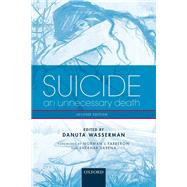
Suicide An unnecessary death
by Wasserman, Danuta-

This Item Qualifies for Free Shipping!*
*Excludes marketplace orders.
Rent Textbook
Rent Digital
New Textbook
We're Sorry
Sold Out
Used Textbook
We're Sorry
Sold Out
How Marketplace Works:
- This item is offered by an independent seller and not shipped from our warehouse
- Item details like edition and cover design may differ from our description; see seller's comments before ordering.
- Sellers much confirm and ship within two business days; otherwise, the order will be cancelled and refunded.
- Marketplace purchases cannot be returned to eCampus.com. Contact the seller directly for inquiries; if no response within two days, contact customer service.
- Additional shipping costs apply to Marketplace purchases. Review shipping costs at checkout.
Summary
Drawing on the latest research by leading international experts in the field of suicidology, this new edition provides clinicians with an accessible summary of the latest research into suicide and its prevention. The abundance of new literature can make it difficult for those whose clinical practice involves daily contact with suicidal patients to devote sufficient time to penetrating the research and, accordingly, apply new findings in their clinical practice. In light of the WHO Mental Health Action Plan 2013-2020, this new edition is a timely contribution to the field, and a vital and rapid overview, that will increase awareness of suicide prevention methods.
Author Biography
Danuta Wasserman, Professor of Psychiatry and Suicidology, National Centre for Suicide Research and Prevention of Mental Ill-Health (NASP), Karolinska Institutet, Sweden
Professor in Psychiatry and Suicidology at Karolinska Institutet (KI), Danuta Wasserman is the Founding Head of the National Centre for Suicide Research and Prevention of Mental Ill-Health (NASP) at KI, Stockholm, Sweden since 1993. She is also the Director of the WHO Collaborating Centre for Research, Methods Development and Training in Suicide Prevention, and expert advisor to the WHO Office in Copenhagen and Geneve since 1995. Professor Wasserman was President of the European Psychiatric Association (EPA) from January 2013 - January 2014. She is a former President of the International Academy of Suicide Research (IASR) and is also Honorary President of the Swedish-Estonian Institute of Suicidology. On a National and Nordic level, Professor Wasserman has built up a National Centre for Suicide Research and the Prevention of Mental Ill-Health and a strong Nordic research network on the prevention of mental disorders.
Table of Contents
Section I Epidemiology
1. Suicide in the world, Alexandra Fleischmann
Section II Theoretical models of suicide behaviour
2. Stress-vulnerability model of suicidal behaviours, Danuta Wasserman and Marcus Sokolowski
3. The suicidal process, Danuta Wasserman
4. Neurobiology of suicide and attempted suicide, J. John Mann and Victoria Arango
5. Social dimensions of suicide, Ilkka Henrik Makinen
Section III Risk groups for suicide
IIIA Psychiatric disorders
6. Depression, bipolar disorders and suicide, Danuta Wasserman
7. Alcohol, other psychoactive substance use disorders and suicide, Danuta Wasserman
8. Anxiety and suicide, Jan Fawcett
9. Eating disorders and suicide, Danuta Wasserman
10. Adjustment disorders and suicide, Danuta Wasserman
11. Suicide risk in schizophrenia, Alec Roy and Maurizio Pompili
IIIB Personality disorders
12. Personality disorders and suicide, Danuta Wasserman
IIIC Somatic disorders
13. Physical illnesses and suicide, Jouko Lonnqvist
Section IV Risk situations for suicide
14. Negative life events and suicide, Danuta Wasserman
15. Suicidal people's experiences of trauma and negative life events, Danuta Wasserman
16. Attempted suicide as a risk factor for suicide, Lars Mehlum
17. Immigrant populations and suicide, Ahmed Hankir and Dinesh Bhugra
18. Suicide in the Criminal Justice System, Marco Sarchiapone
19. Suicide in the Armed Forces, Vsevolod A. Rozanov
Section V Age-related suicide
20. Adolescent suicide and attempted suicide, Alan Apter and Yari Gvion
21. Older adults and suicide, Siobhan T. O'Dwyer and Diego De Leo
Section VI Suicide Risk Assessment
22. Suicide risk assessment, Danuta Wasserman
23. The suicidal patient-doctor relationship, Danuta Wasserman
24. Heuristics and biases in suicide risk assessment, Gergo Hadlackzy
25. Psychometric scales in suicide risk assessment, Per Bech, Lis R. Olsen, and Goran Hogberg
26. Strategies in suicide prevention, Danuta Wasserman
Section VII Health care perspective
27. Pharmacological treatment of underlying psychiatric disorders in suicidal patients, Hans-Jurgen Moller
28. Psychological Treatments for Suicidal Individuals, Megan Chesin, Andriy Yuryev, and Barbara Stanley
29. Education of general practitioners in depression and suicide prevention, Wolfgang Rutz and Zoltan Rihmer
30. Collaboration between psychiatrists and other physicians, Jean-Pierre Soubrier
31. The work environment for healthcare staff, Danuta Wasserman
32. A psycho-educational perspective on family involvement in suicide prevention and postvention, Karl Andriessen and Karolina Krysinska
Section VIII Public Health Perspective
33. Perestroika in the former USSR: history's most effective suicide-preventive programme for men, Danuta Wasserman and Airi Varnik
34. Controlling the environment to prevent suicide, Annette L. Beautrais
35. Suicide prevention through the Internet, Vladimir Carli
36. Suicide prevention in schools, Danuta Wasserman and Veronique Narboni
An electronic version of this book is available through VitalSource.
This book is viewable on PC, Mac, iPhone, iPad, iPod Touch, and most smartphones.
By purchasing, you will be able to view this book online, as well as download it, for the chosen number of days.
Digital License
You are licensing a digital product for a set duration. Durations are set forth in the product description, with "Lifetime" typically meaning five (5) years of online access and permanent download to a supported device. All licenses are non-transferable.
More details can be found here.
A downloadable version of this book is available through the eCampus Reader or compatible Adobe readers.
Applications are available on iOS, Android, PC, Mac, and Windows Mobile platforms.
Please view the compatibility matrix prior to purchase.
